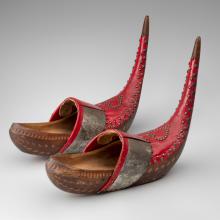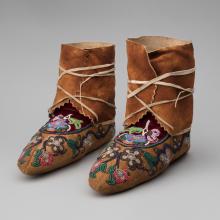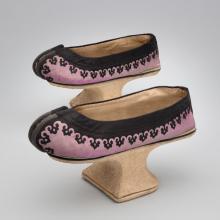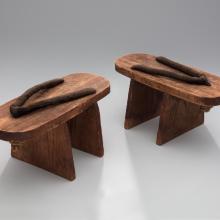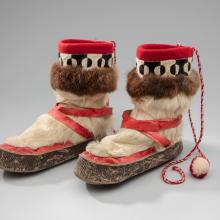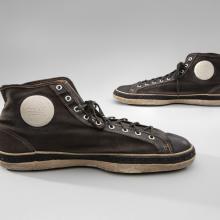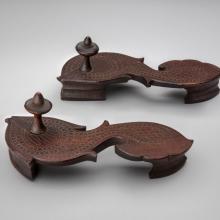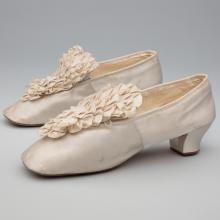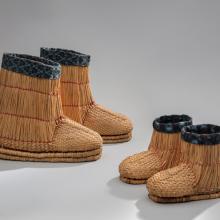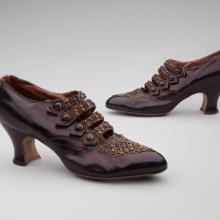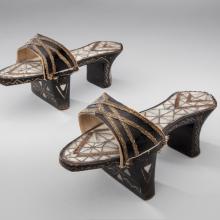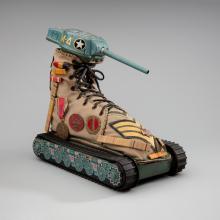International Terminal









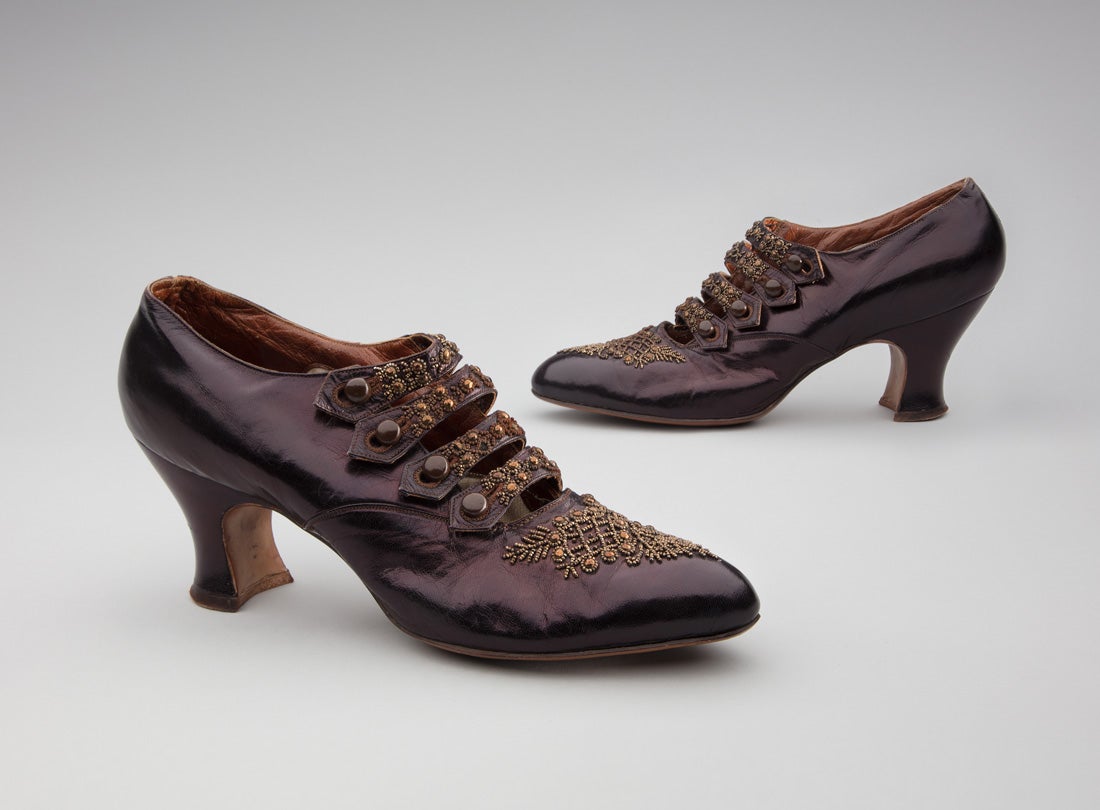


Clogs (sabots) early 20th century
Valley of Bethmale, France
walnut, leather, copper
Collection of the International Clog Museum (Klompenmuseum)
ME 216
L2017.0103.002a,b
Clogs, carved wooden shoes, are made from a single piece of wood. Poplar, willow, birch, and alder were common wood types used in the Netherlands and France. Antique clogs are rare because old clogs were typically used for firewood once they wore out. Known as klomp in the Netherlands and sabot in France, they were worn throughout many parts of Europe beginning in the thirteenth or fourteenth century. Clogs were often worn by people working in the fields to keep their feet from getting blemished or muddy; by industrial workers in factories; by market sellers, such as fishmongers; and also by the upper classes while outdoors to protect their feet and clothing from the elements. Clog makers could be found in villages in Europe through the early twentieth century.
Particular patterns and colors on clogs revealed the village or area from which a person lived. Fancier, painted clogs might be worn to church or for festive occasions, such as weddings. Wooden shoes with very high tips, such as the ones here, were worn in the Valley of Bethmale, France. Clog makers manipulated the wood in a special manner so that the clog could be made from a single piece of wood.
Moccasins c. 1940
Gwich’in
Alaska
glass beads, suede, velvet, thread
Collection of the California Academy of Sciences
CAS 0005-0389a,b
L2017.0101.010a,b
Prior to European colonization, Native American footwear displayed a variety of distinctive adornment and design styles. Materials varied depending on the climate and what was locally available. Making moccasins was a skill passed from one generation to the next. Women were generally responsible for preparing and tanning the hides, cutting and sewing the moccasins using thread made from animal sinew, and embellishing the footwear. Moccasins are decorated using beads, vegetable dyes, animal fur, ribbons, embroidery, appliqué, porcupine quills, and decorative metal cones. Some of these materials, such as glass beads, which became available in the mid-1700s, were acquired through trade with European-Americans. Decorations including animals, plants, and geometric designs indicated the skill of the maker as well as the cultural affiliations of the group.
Manchu platform shoes late 19th–early 20th century
China
fabric, embroidery thread
Courtesy of Sally Yu Leung
L2017.0107.007a,b
The semi-nomadic Manchu conquerors who founded the Qing dynasty (1644–1911) embraced much of the cultural and artistic practices of the Han Chinese. However, they rejected female foot binding, in which young girls’ feet were bound to keep them extremely small. Foot binding conveyed a woman’s prominent place in Han society and made her more desirable to men. Instead of forcibly reshaping the foot, elite Manchu women showcased their prestige by wearing platform shoes. The upper parts of the shoes were often elaborately embroidered with a variety of motifs and made of colorful silk or satin brocade. The platform shoes produced a stilted gait that slightly emulated the desirable “lotus walk” of women with bound feet. Such shoes also helped to keep feet and clothing hems clean and dry.
Stilted sandals (geta) 19th–early 20th century
Japan
wood
Collection of the Fowler Museum at UCLA; Gift of the Wellcome Trust
X65.4194.1
L2017.0113.001a,b
In Japan, it is customary to remove shoes indoors. The zori, a sandal with a cloth thong, remains a practical shoe, easy to slip on and off. For centuries, zori have been fabricated from wood or lacquered wood and cloth. The zori inspired the beach shoe or flip-flop in the West. Similar to the zori but elevated in height, geta became fashionable in urban areas during the Edo period (1615–1868). Wooden stilts or “teeth” elevate geta, which range in height from around two-to-six inches. Japanese geisha wore finely made, lacquered, high-platform geta, which required slow, short steps. Such footwear signified the geisha’s social standing while protecting her kimono from dirt and water. Geisha, however, were not the only ones who wore geta; both sexes and various classes of people wore these platform sandals in order to protect their feet and clothing.
Boots mid–1900s
Iñupiat
Alaska
sealskin, caribou skin, rabbit skin, sinew, cloth, yarn, dye
Collection of the California Academy of Sciences
CAS 0403-0002a,b
L2017.0101.025a,b
In the Arctic regions, indigenous groups wore boots often referred to as mukluks or kamiks. In the subarctic, native peoples also wore various styles of animal skin boots, many of which were covered in fur. Because of the severe cold, the waterproof quality of sealskin made it preferable in wetter climates, while caribou skin was commonly used in colder, drier climates. There is a tremendous variety in boot styles, tools, materials, preparation, and construction techniques between cultures. Women were, and continue to be, the primary producers of clothing and footwear. The production of footwear is a lengthy and complex process that involves preparing skins, creating and cutting out pattern pieces, and sewing them together. Women traditionally used bone tools and animal sinew as thread. Fish oil was typically employed to waterproof boots.
Sneakers c. 1910
Hood Rubber Co.
Watertown, Massachusetts
Courtesy of The California Sneaker Museum
L2017.0102.031a,b
The invention of vulcanization in the nineteenth century enabled the creation of durable, flexible rubber products including tires and shoes with rubber soles. By the 1870s, rubber-soled shoes were used in sports and leisure activities, such as tennis. They were called sneakers because the rubber soles made them so quiet that the wearer could easily “sneak up” on another person. In 1891, basketball—associated with sneakers more than any other sport—was invented in Springfield, Massachusetts, by Canadian-American James Naismith. The U.S. Rubber Company began selling sneakers using the name Keds in 1917. The same year, the Converse Rubber Shoe Company, which initially made rubber galoshes, released the famous Converse All-Star basketball sneaker, a canvas high top with a patch on the ankle. When basketball player and coach Charles Hollis “Chuck” Taylor began endorsing the sneaker in 1921, its popularity skyrocketed. In 1934, he became the first person to have his name on sneakers.
Toe-knob sandals (padukas) 19th–20th century
India
wood
Collection of the Fowler Museum at UCLA; Gift of the Wellcome Trust
X65.4188.1
2L2017.0113.005a,b
One of the oldest forms of footwear in India, the paduka, a toe-knob sandal with an elevated sole, is still worn today. For hundreds of centuries, this ancient design has kept the foot elevated above the hot earth while protecting feet from ground debris. Commonly made from solid wood, more elaborately designed examples were crafted from silver, brass, and ivory. Many fine wooden pairs made of teak, ebony, or sandalwood were intricately carved, some in the shape of fish, which symbolize fertility and abundance. Others were incised or inlaid with ivory, brass, silver, or gold.
Although all classes wore padukas, finer materials and intricate adornment reflect the status of their wearers. Some padukas were only worn for special occasions, such as weddings. Religious teachers or holy men often wore padukas, and pilgrims on religious journeys occasionally wore wooden padukas with metal spikes.
Wedding shoes 19th century
United States
silk
Courtesy of California State Parks, Sonoma State Historic Park
L2017.0112.001a,b
For around two hundred years, Western women have traditionally worn white or ivory on their wedding day. In the eighteenth century, some wealthy women chose to wear white for their wedding dresses, but other colors and patterned silks were also popular with brides. White clothing was a status symbol as it took a great deal of time and effort to keep the clothing pristine. The color white has long been associated with purity and innocence, so the color also had important symbolism. In the last decade of the eighteenth century, more women began wearing white. In 1840, Queen Victoria of Britain married Prince Albert in a white wedding dress wearing a veil and carrying an orange blossom wreath. The event was highly publicized in newspapers and periodicals of the day. As a result, women from all levels of society aspired to wear white with accompanying veil and bouquet on their wedding day.
For a short period in the 1920s, metallic lamés and lace, pale gold, and shell pink fabrics became fashionable bridal attire. The classic white wedding dress returned to favor during the 1930s and its preeminence continues to this day. Matching shoes have long been an important part of a woman’s wedding ensemble.
Snow boots (fukagutsu) 20th century
Japan
palm fiber
Gift of Esther and Morgan Sinclaire
Collection of Mingei International Museum
2009-05-111a,b; 2005-T35-165a,b
2009-05-112a-b; 2005-T35-166a-b
L2017.0104.005a,b; L2017.0104.006a,b
Straw, the byproduct of rice and other plant life, served as one of the most plentiful materials for crafting items in Japan. Some of the many items made from straw include clothing, shoes, hats, and containers. The oldest style of shoes still worn in Japan consists of sandals made of straw twisted into ropes and plaited to form the sandal’s sole, with the ropes acting as straps. Known as waraji, they were traditionally worn by peasants and probably introduced from China in the eighth century. In addition to sandals, straw boots are called fukagutsu. They are still worn today in snowy, mountainous regions of Japan. They differ stylistically in height and shape depending on the area where they are made and the amount of snowfall.
Barrette shoes c. 1900–15
Carson Pirie Scott
United States
leather, steel beads
anonymous lender
L2017.0109.004a,b
At the turn of the twentieth century, women’s ankles were covered with long skirts, silk stockings, and tight-fitting, feminine ankle boots. The majority of shoes were black, brown, or white, with some pastel and rich colors for evening wear. Part of the reason for the predominance of black and brown shoes was because people believed that darker colors made feet look smaller. Dressier styles of brown and black footwear might be embellished with beading. American machine-beaded ladies’ shoes became readily available for purchase in the 1880s. Generally, leather was preferred for most footwear in the late 1890s and early 1900s, although silk was still worn for wedding and evening attire. As the century progressed and women’s skirts became shorter, they began to wear showier shoes. Buttons and laces were commonly used as closures on shoes and boots in the early 1900s. The wide, curved Louis heel, which originated in the 1700s, re-emerged in the 1870s and remained the common dress-shoe heel until the mid-1920s.
Clogs (nalin) 20th century
Turkey
wood, mother-of-pearl, leather
anonymous lender
L2017.0119.002a,b
For centuries the public bath or hammam served an important role in Middle Eastern culture. In addition to bathing, hammams were gathering places where both men and women could separately socialize and relax. Special wooden bathing clogs called nalin were made with elevated heels similar to Japanese geta. Their high stature protected the wearer’s feet from the wet floors, though it is hard to imagine how bathers managed to walk in nalin, especially on slippery marble surfaces. The base of the platform shoe was generally carved out of solid hardwoods and embellished with silver, gold, mother-of-pearl, or tortoise shell. The strap of the nalin, which wrapped over the user’s foot, was made from fabric or leather and often decorated with stones, pearls, and embroidery. The various heights of nalin and the quality of decorative materials demonstrated the wearer’s prestige. Nalin also served as an important part of a woman’s dowry chest.
Today, people often wear wooden clogs called takunya in Turkish baths, which are also worn outdoors. The readily available shoes are made using a combination of hand- and machine-sewn techniques.
Combat boot 1974
Mickey McGowan (Apple Cobbler)
Marin County, California
khaki, medals, toy parts
Courtesy of the artist
L2017.0108.007
Motivated by the lack of color, whimsy, and alternatives to leather in footwear, artist Mickey McGowan taught himself to make shoes. In 1969, he moved from Los Angeles to Marin County, California. Inspired by the world around him and his dreams, he made eccentric, imaginative shoes in his Mill Valley studio throughout the 1970s. Dubbed the Apple Cobbler, he crafted many shoes both for utility and as works of art. Attached to his studio, he housed his Unknown Museum, a repository of twentieth-century popular material culture—displaying everything from stacks of television sets to rows of Mr. Potato Heads. McGowan’s fervent interest in popular culture deeply influenced his footwear designs, which encompassed everything from rubber ducks to toy tanks, Campbell’s soup cans, and Popeye cartoons. And with his strong musical bent, members of The Tubes, Journey, The Doobie Brothers, Grateful Dead, and jazz musician Charles Lloyd all wore his footwear. Local artists, writers, and other bohemians also purchased his quirky creations.
